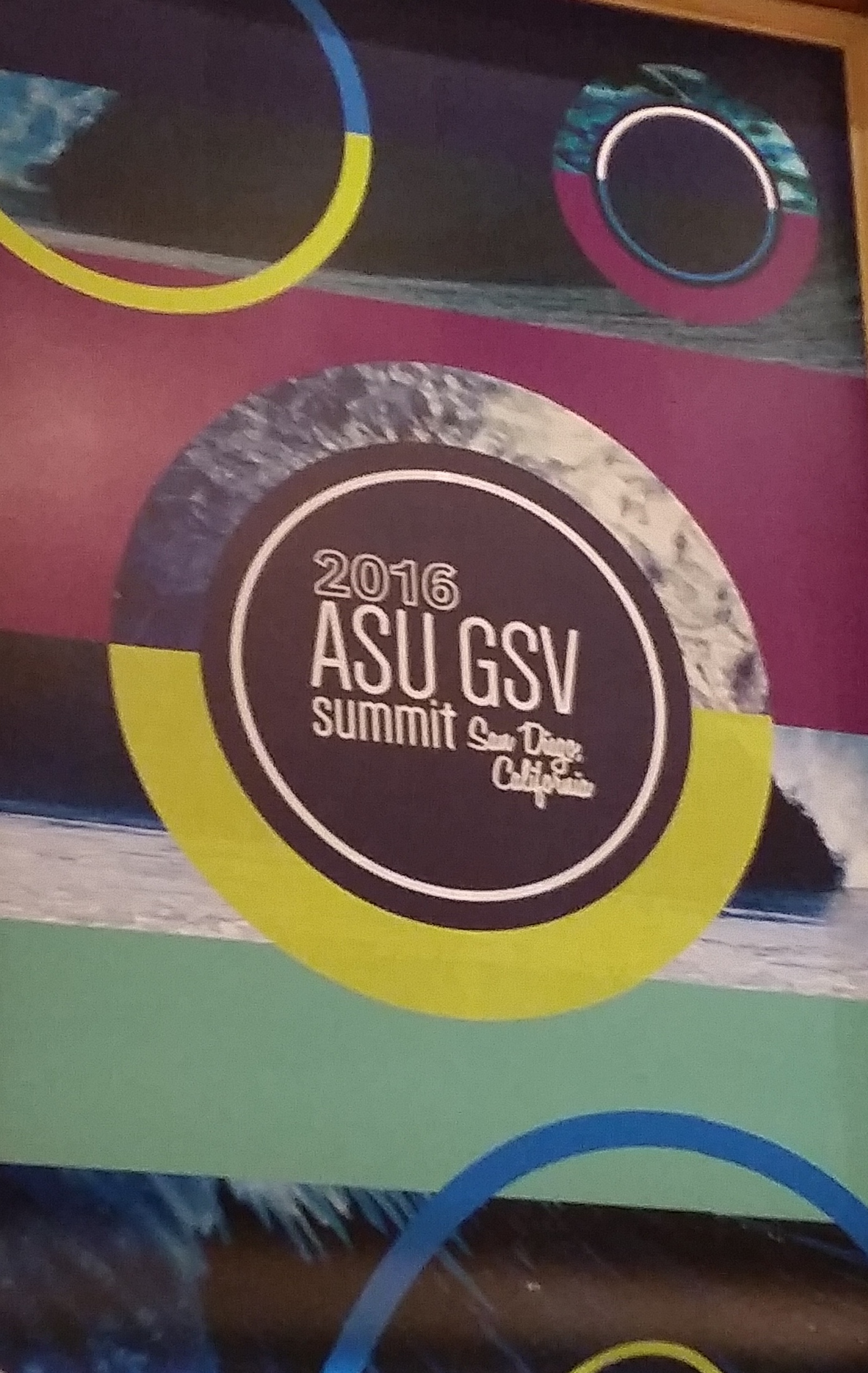You have /5 articles left.
Sign up for a free account or log in.
SAN DIEGO -- The ASU GSV Summit that was held here this week is easy to caricature. Robots roamed the hallways, thousands of attendees hung on every word as Bill Gates described his work in education, and technology companies big and small promoted their products and begged for dollars from Silicon Valley and other investors who are pouring money into education right now.
The meeting, which shifted to this California city because it had outgrown its original home base in Phoenix, has in the eyes of many become the most important meeting on education technology in the country.
But a major weakness of the meeting in recent years has been the dearth of attendees who actually educate for a living -- few college administrators or instructors (or high school teachers or superintendents, for that matter) have attend the pricey and clubby event.
That deal-making demography has also had a powerful influence on the nature and tenor of the discussions, both in the formal program and in the hallways. The operating assumption for many of the tech company execs and investors whose funds are fueling the start-up frenzy around the education industry is that higher education is “broken” and that they have the answers to either fix it or, in some cases, replace it.

The 2016 meeting seemed to mark the beginning of a shift in the ASU GSV vibe. Let’s not overstate it: the vast majority of attendees are still representatives of technology companies and various people with money and influence, from investment firms to foundations.
But college and university administrators and faculty members were better represented this week than in years past, in part because conference backers paid to bring them here. (The Gates Foundation, for example, brought roughly 20 representatives of some of the colleges it is working with to the meeting.)
About 10 percent of the roughly 3,500 attendees were employees of colleges or universities, although almost one in 10 of them were from the university whose name is in the conference title, Arizona State University.
Some of the college officials complained that they felt like they had targets on their backs, barraged by requests for meetings from the hundreds of companies, especially the many start-ups that are desperate for customers willing to give their products a try and a possible foothold in the market.
But they very much helped alter the tone of the meeting, from one in which higher ed is assumed to be a static, foundering enterprise to one that recognizes it is willing to adapt and capable of adapting, if more slowly than might be ideal.
At one of several sessions on whether college degrees would continue to be relevant -- a favored theme at events like this, where much of the energy is around alternative credentials like those provided by coding boot camps, the darlings of the moment -- Arthur Levine offered a succinct history lesson designed to show that “credentials change all the time, it’s normal” and undermine the fevered assertion that higher education is crumbling.
Levine, head of the Woodrow Wilson Foundation and former president of Teachers College of Columbia University, related that as the industrial revolution took hold in the early 1800s, the Connecticut legislature complained to Yale University that its curriculum was irrelevant. Yale formed a committee that (predictably, Levine said) concluded, “yes, we are relevant,” “denying that change was necessary.”
But within several years, Levine said, Yale and most other universities had adapted their academic programs by breaking them into courses, awarding A-F grades and measuring them based on the Carnegie unit.
Flash forward to today, as we shift from an industrial to a digital economy, he said, and the same conversation (and argument) is unfolding, with debates about competency-based education, the continued relevance of the Carnegie unit, the need for microcredentials, etc. 
“We’re seeing the pattern repeating -- resisting change, heated debate about the future, all kinds of experiments, seeing new models emerge,” Levine said. “That’s how we’ll get to the creation of a new,” evolved higher ed system. “It’s all normal, it’s all predictable.” Cool your jets and your disruption rhetoric, he was essentially saying to the Silicon Valley types.
College leaders weren’t reluctant to call BS when they saw it. At a session on community colleges’ role in workforce development, the moderator, Daniel Pianko of University Ventures, asserted that many of the conference attendees believed that community colleges, like most postsecondary institutions, were “part of the problem, not part of the solution” to the issues facing employers and society.
Scott Ralls, president of Northern Virginia Community College and former chancellor of the North Carolina Community College System, acknowledged that the institutions “have our challenges” but said, “For a lot of people who challenge us, they’ve never been at a community college.” Many hands went up when Pianko asked how many in the audience had been on a community college campus for more than a drive-by, but another show of hands revealed there were few ed-tech entrepreneurs in the audience, and few of them could say the same.
Pam Eddinger, president of Bunker Hill Community College, said that her institution was hounded by entrepreneurs believing they had the answer to her students’ problems. Her response: “Unless you can give me an app that my [student who is a] mom or dad can use in 15-20 minutes to compress their learning, it’s not going to help my student.”
It would be unfair to make it seem as if the college officials were wholly responsible for the shift in tone. Some of the most successful technology companies in the higher ed space have made it their business to treat universities as partners and faculty members as necessary collaborators in innovation rather than cogs to be innovated out of their jobs.
And more and more tech leaders expressed similar sentiments at the ASU GSV Summit, seeming to have adopted the goal of working with existing institutions to improve rather than striving to create alternatives to them.
In the same session on “innovating the academic credential” at which Levine offered his history lesson, one questioner (in the worst of ed-tech know-it-all fashion) asked what would happen to the viability of college-issued degrees and other credentials “when machine-based learning issues credentials itself?”
Matt Pittinsky, CEO of Parchment, tactfully responded that the degree is “more than the sum of competencies and courses” and that much of the recent conversation about alternative credentials “forces you to look in the mirror” and ask, “Have we really commoditized or reduced the degree to that conception of what it is?”
“You can have all the parts and it’s not the full sum,” he said. “Machine learning is not the answer to an undergraduate degree.”
That kind of statement may still not be the norm at the ASU GSV meeting, and the term “disruption” would almost certainly dominate a word cloud of all the utterances there this week. But it probably seemed a little bit less like a foreign (and hostile) land than it has in the past.









